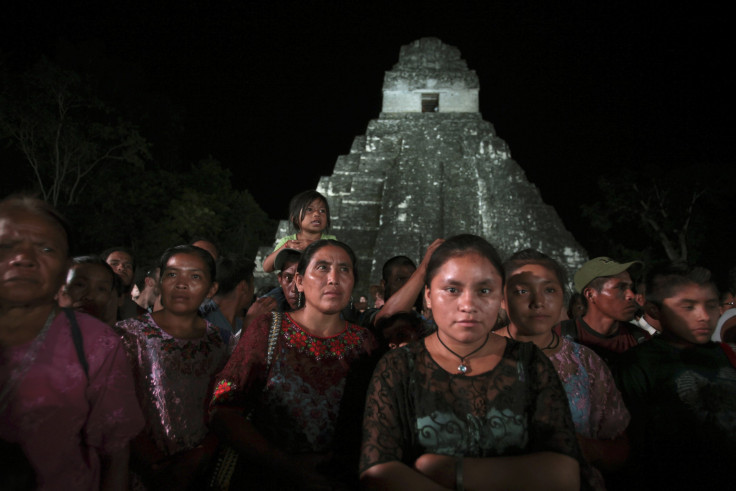Mayan Ruins Damaged, Ceremony ‘Hijacked’ Amid ‘Apocalypse’ Frenzy

It’s now been a week since the supposed Mayan apocalypse came and went, and if you’re reading this article, that should be proof enough that the world did not end. Indeed, many of us are still laughing about the public hysteria in China and Russia, and the mountaintop in France that was to open up so that aliens could emerge with spaceships to save all humans nearby. But what happened at an iconic Maya ruin in Tikal on Dec. 21 is no laughing matter.
Carla Molina, president of Guatemala City-based Ecotourism & Adventure Specialists (which maintains the website TikalPark.com), just returned from spending time at Tikal, where she said “our cultural and natural heritage laws were abusively disrespected by the Guatemalan President, Otto Perez, and the Director of the Tourism Board, Pedro Duchez.”
Perez, she said, ushered in a host of private guests, including Costa Rican President Laura Chinchilla, aboard a private helicopter, which flew well below the 2,500 feet limit required around Guatemala’s historic ruins. The president, along with Guatemala’s tourism board, Inguat, then “hijacked the park and made it their own private event.”
“In the end, there was a rather uncomfortable moment when the indigenous people were not allowed to hold their ceremony where they wanted it at sunset. They held up signs saying they were not in agreement with what was going on,” Molina said, adding that people did not obey the order of the park nor the laws of the country that govern sacred sites, mostly because the tourism board and the president essentially stripped the park authorities of their power.
“Tikal’s Great Plaza is not a disco,” she said. “But they had generators behind Temple I and Temple II illuminating the ruins. Tourists went up the stairway of Temple II because the plaza had been hijacked even though it’s not equipped to be an auditorium. It’s forbidden to go up there. This is all clearly illegal.”
Molina’s account of what happened at the ruins on Dec. 21 comes just days after the director of the archeology unit at Tikal claimed that at least one ruin was irreparably damaged during the event.
“Sadly, many tourists climbed Temple II and caused damage,” Osvaldo Gomez told local media. “We are fine with the celebration, but [the tourists] should be more aware because this is a [Unesco] World Heritage Site.”
Some 550 kilometers (340 miles) north of present-day Guatemala City, Tikal emerged from the jungle as early as the 4th century B.C. and grew in importance during the height of the Maya Civilization between 200 A.D. and 900 A.D. At its peak, it covered a landmass of nearly 50 square miles, housed an estimated population of 55,000, and controlled much of the Maya region politically, economically and militarily.
There are over 3,000 structures protected within Tikal National Park today, and park rules clearly forbid people to climb the stairs of the 38-meter (125-foot) Temple II, which faces the central plaza and is one of the most iconic structures of the Maya Civilization. But Molina described a scene where many tourists did not respect the spiritual grounds, in part, she said, because the government didn’t either. At one point, she remembers helping medics clear out tourists from the temple grounds who had apparently overdosed on illegal substances.
For most, the “end of the world” came and went with little fanfare, but many Maya were left with a sour taste in their mouths after an eager government and fanatical believers turned their decidedly un-apocalyptic event into a profit-maker. Not only did they not get to hold their ceremony as they’d originally planned it in Tikal, but those who came and hijacked their event destroyed a bit of their heritage in the process.
© Copyright IBTimes 2024. All rights reserved.






















